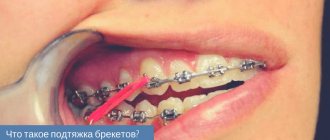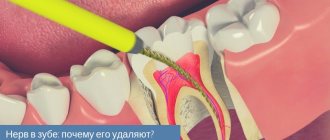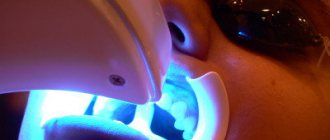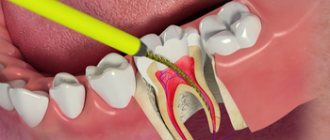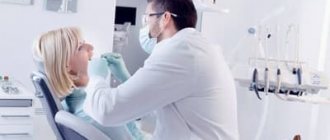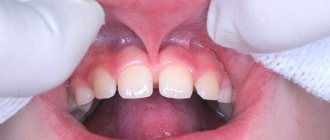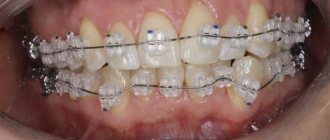To correct an abnormal bite, you can put braces on your teeth. Such orthodontic systems affect bone tissue, muscles and ligaments, and help slowly move teeth into the correct position. Many people are interested in the question: is it possible to put braces on one jaw? You will find the answer in this article.
In this article
- What are braces?
- Are braces placed on one jaw?
- Main indications for partial correction
- Orthodontic correction up to 12 years
- Braces for the lower jaw only for mild crowding
- Treatment for crowded upper anterior incisors
- Closing the gap between the front incisors
- Partial bracket system for preparation for prosthetics
- Absence of chewing teeth on the opposite jaw
- Should I install braces on one jaw or not?
What are braces?
A brace system is an orthodontic device that is installed on the teeth and helps them move in the desired direction. Structurally, this device consists of small plates (directly braces), which are glued to the dental crown at pre-calculated points, and a metal arch. This arc has shape memory and is an active element of the system. Fixed on the plates, it tries to regain its even position and thereby puts pressure on the teeth. As a result, their slow, gradual movement in the bone tissue occurs. Orthodontic treatment not only helps to correct the curvature of individual teeth in a row, it allows you to change the shape and position of the jaw, and restore facial symmetry.
It is preferable to begin orthodontic correction in childhood. But modern medical capabilities make it possible to carry it out even in adulthood and old age.
Most often, an orthodontic device is placed on two jaws at once. The dentist calculates in advance in which direction a particular tooth should move, how much it is necessary to expand the jaw or spread the dentition. Double-jaw treatment is comprehensive and allows you to solve global problems in occlusion correction. It usually takes from several months to several years.
Types of orthodontic appliances, design and materials
The design consists of the following elements - ligature, metal arches and elastic, braces made of metal or other materials. The device is used to transfer pressure to the surface of the row. This causes a restructuring of growth to give the row a normal position. The exerted force affects the movement of units in a row, allows you to correct it and eliminate growth pathologies.
The following types of constructions are used for correction:
- Vestibular orthopedic devices are attached from the outside. They are visible when worn, but provide high results. The design does not have a negative effect on the enamel if the Patient follows the care recommendations.
- Lingual systems are installed from inside the row. They are not noticeable when talking, but the cost of treatment will be higher due to more complex installation. In addition, an adjustment period is required, since at first the device may interfere.
The following materials are used for the manufacture of braces:
- metal, characterized by affordable cost, durability, reduced treatment time;
- ceramic, inconspicuous in appearance, durable, but susceptible to staining with food pigments;
- silicone based on special plastic, these are transparent structures that are distinguished by high aesthetics, but are indicated for correcting minor pathologies and slight curvature;
- sapphire transparent systems with high aesthetics, almost invisible on the enamel surface;
- combined, for example, sapphire braces are used for the upper row, and ceramic or metal-based for the lower row.
Installation Features
Fixation order:
- initial examination;
- Carrying out diagnostics, identifying problems, calculating treatment regimens;
- choice of design type;
- installation of orthodontic braces (takes about 1-1.5 hours);
- regular visits to the doctor to adjust the design;
- removal of the device;
- evaluation of the result and installation of a special structure to consolidate the result.
Price
We offer competitive rates for treatment and a free initial examination. The total cost of jaw braces depends on the following factors:
- condition of the oral cavity, the presence of diseases subject to preliminary treatment;
- performing office cleaning of plaque and stone deposits;
- prescribed diagnostic measures, consultations with related specialists;
- materials, type of construction, manufacturer;
- installation, activation of the device (calculated for each jaw separately);
- regular visits to tighten the arch and replace individual elements;
- the use of special devices after correction with braces.
About Us
Magenta Dental Clinic is a modern dental clinic offering services such as eliminating dental pathologies and restoring a beautiful, sparkling smile without pain and in the shortest possible time. Patients are provided with:
- modern methods of therapy;
- use of certified materials and equipment;
- full range of services, including diagnostics;
- control of treatment, guarantee of results;
- attentive attitude towards everyone, creation of comfortable conditions;
- affordable cost of jaw braces;
- free initial consultation with clinic doctors.
To make an appointment, leave a request on the website, indicating the coordinates for feedback. Call us at +7 (812) 242-91-90. You can also send a request for an appointment at a convenient time by email and consult with our doctors.
Are braces placed on one jaw?
Installing a brace system is one of the most common and effective methods for correcting an abnormal bite, improper closure of the teeth of the upper and lower jaw. Crooked teeth and abnormal jaw position not only spoil a person’s appearance, but also affect his health. Therefore, correcting the bite is important and necessary. But installing braces confuses many people.
Some are concerned about aesthetics, others are concerned about possible inconveniences when wearing the system, others simply want to save on orthodontic correction. And then the patient turns to the doctor with the following question: is it possible to install braces only on the upper jaw or only on the lower jaw.
As a rule, a person knows in advance which teeth he wants to change. And if they are located only on one jaw, then he expects that he will have a partial braces installed, only in the area of the curvature.
The doctor must make such a decision. It may seem to the patient that he has a problem only with the lower jaw, but the dentist sees during the examination that partial correction will not give an effective result. In this case, the orthodontist will insist on a complete correction. If you need a stable result of orthodontic treatment, we recommend listening to the professional opinion of an orthodontist.
Location of braces on implants and dentures
Adult patients often worry that they will not be able to install braces if they have a large number of fillings or crowns in their mouth. There are no contraindications in this case, but it is worth understanding that braces on artificial material may have a worse hold. As a result, the patient will need to visit the orthodontist more often than usual. This is necessary to assess the condition of the oral cavity and the tightness of the staples to the enamel surface.
The situation with implants is different. In the event that the implantation was performed 4 by 4 or 3, treatment with braces will most likely be impossible. This is explained by the fact that titanium artificial roots grow too closely with the bone tissue, so it will not be possible to displace them like ordinary roots.
Of course, one implant may not be a serious obstacle to orthodontic treatment, but all cases are considered on an individual basis. If there is a need for implantation, but the implant has not yet been installed, it is better to first correct the bite and only then implant an artificial root and install a prosthesis.
Main indications for partial correction
In some cases, it is indeed possible to place braces on one jaw, and this approach will be effective. As a rule, these are situations where the teeth are only crooked at the top or bottom, but the bite is not broken and there is no facial asymmetry. Partial correction may be recommended for the following indications:
- one or two teeth are positioned incorrectly;
- slight crowding of teeth (lack of space - up to 3 mm);
- a gap between the front incisors in the absence of pathological closure of premolars and molars;
- correction of the position of teeth before installing dentures;
- the need to avoid sagging of the upper teeth when their antagonists (opposite units) in the lower jaw are absent.
Diagnostics will show how effective braces will be only on the upper jaw or, conversely, on the lower jaw. It should include a visual examination, x-rays, assessment of the condition of bone tissue and dental roots.
Let's consider cases when it is justified to place braces separately on the upper jaw and separately on the lower jaw.
Kinds
The following types of materials are used to make braces:
- metal structures, characterized by an affordable price for braces for both jaws, durability, easy installation and adjustment;
- ceramic, inconspicuous, durable, preserving the aesthetics of the frontal area;
- silicone transparent, characterized by high aesthetics, but indicated for the correction of minor pathologies, slight curvature;
- sapphire systems based on a single crystal, which have high aesthetics and are almost invisible on the enamel surface;
- combined, for example, transparent ceramic or sapphire braces are used for the top row, and metal-based for the bottom row.
Orthodontic correction up to 12 years
Braces are primarily used for children starting in their teens. This is due to the fact that by the age of 11-12 years the formation of the jaws is completed, and the primary bite is replaced by a permanent one. But often, an orthodontist discovers bite problems in a child at an earlier age. Installing partial braces helps solve some of them, as well as prepare teeth for further correction in adolescence.
The doctor can place an orthodontic device on one jaw or individual teeth in order to:
- create space for the eruption of permanent teeth;
- expand one of the jaws;
- close the gap between the front incisors (the so-called diastema);
- correct the incorrect position of one or more teeth that are bothering the child;
- preserve the space left after early removal of baby teeth, which neighboring ones are trying to occupy.
Thus, braces can be placed on one jaw at the age of 9-10 years to solve a specific orthodontic problem. In this case, in adolescence, further, already double-jaw, treatment will be required.
How do braces work?
Naturally, the doctor works with each patient individually. There are many types of braces, as well as many types of malocclusions. Already during the consultation, it becomes clear what problem is relevant and how to solve it.
How do braces work? After choosing a design, the doctor will carefully place the lock in the desired position on each tooth. Here it is important to take into account not only the position of individual teeth, but also the condition of the entire row. After all, even a small change in the position of one element leads to a displacement of all the others. Therefore, it is extremely important to configure everything correctly.
During treatment, the patient must regularly visit the doctor for preventive and corrective examinations. As the correction progresses, the doctor will gradually move the braces, adapting them to the new position of the teeth.
Braces for the lower jaw only for mild crowding
Crowding is the position of teeth when they are too close to each other. As a result, rotation, curvature, and “layering” of each other occur. If slight crowding is observed only on the lower front incisors, while the upper front incisors are positioned evenly and the lateral ones close correctly, in this case, braces are sometimes placed only on the lower jaw. An important condition for this method is that there must be enough space to move horizontally so that the teeth can take the correct position. This treatment method is chosen in cases where the lack of space for alignment is less than 3 mm. With this method, separation of the front incisors is almost always performed - that is, minor grinding of the contact surfaces, which allows you to free 0.25 mm from each surface and in total create those missing 1-3 mm for alignment in the dentition.
Advantages and disadvantages of installing braces on both jaws
The invention of braces completely changed all previously existing views on aesthetic dentistry. Patients were able to effectively and quickly correct pathologies of the position of teeth and bite, without resorting to highly traumatic surgical interventions.
Meanwhile, orthodontic treatment with braces also has a number of disadvantages. These include:
- the presence of a wide range of contraindications to the procedure (cardiological, oncological, endocrine, allergic, mental diseases, periodontal disease, development of inflammatory processes, alcoholism, etc.);
- long duration of the adaptation period (after installation of an orthodontic device, the patient experiences pain and discomfort for a long time, and encounters problems with diction);
- deterioration in the aesthetics of a smile (except for those cases when lingual invisible braces are used to correct the position of teeth and bite);
- the emergence of difficulties during hygienic procedures;
- the appearance of minor injuries to the oral mucosa;
- the need to follow a special diet (avoiding too hard, viscous foods, etc.);
- relatively high cost of treatment involving the use of braces.
Meanwhile, all of the listed shortcomings quickly lose significance against the background of the achieved results. A beautiful facial contour, a healthy and even smile become a truly worthy reward for all the difficulties that the patient has to cope with during treatment.
Treatment for crowded upper anterior incisors
Braces on the upper jaw only can be placed if crowding is observed on the upper front incisors. The conditions are the same - the space deficit should be no more than 2-3 mm. In addition, treatment should not require expansion of the dentition. In this case, for orthodontic correction it is not necessary to involve the lower dentition.
If you provide space for uneven teeth by expanding the upper row, this will disrupt the closure. As a result, the teeth will “seek contact” with each other, the upper row will become narrow again, and in the long term the goal of orthodontic treatment will not be achieved. Therefore, if it is necessary to expand the upper row of teeth in order to correct crowding, a partial braces system cannot be used; a two-jaw apparatus will have to be installed. Braces can only be placed on the upper jaw if space for teeth is freed up using the separation method (their width is reduced by grinding the contact surfaces).
Differences between structures for the upper jaw and purpose
Using the device only for the upper jaw is recommended to eliminate problems with one or two teeth and in case wearing a mouth guard does not bring results. Externally, this is a classic type of system that can be installed outside or inside the row. Purpose:
- correction of minor malocclusions;
- the number of uneven teeth is small;
- no oral diseases.
For the maxilla, labial braces are commonly used. For those Patients for whom aesthetics are important, transparent braces are recommended. They are hardly noticeable when worn and do not cause discomfort. Materials such as artificial sapphire, ceramics or plastic are used for manufacturing.
Closing the gap between the front incisors
Braces can be placed on the lower jaw if there is a large gap (diastema) between the lower front incisors. In this case, several conditions must be met:
- the lateral teeth close together normally;
- there is an opportunity for a “joint to joint” closure of the front teeth of the upper and lower rows.
If these conditions are not met, it may be necessary to artificially increase the size of those teeth between which there is a gap. This is done using filling material. If the patient is not ready to fill healthy teeth in order to increase their size, then single-jaw treatment of diastema will not suit him, since the doctor will not be able to guarantee the stability of the result.
Braces or mouthguards - which is better?
What to do if only one tooth is crooked? This occurs in the practice of orthodontists. If your bite is normal, your doctor may suggest removable clear aligners. Such structures are placed on a molar or incisor that does not have enough space on the jaw. Typically, aligners are worn for only a few months. However, mouthguards are not used in all cases: if the tooth has turned to the side, treatment with braces is prescribed. Typically, canines and front incisors are corrected with mouthguards.
Placing transparent aligners is much cheaper. But is the question of price always justified? Let's look at the advantages of braces over removable aligners:
- The bracket system puts constant pressure on the tooth, which speeds up the process of straightening the curvature.
- With the help of removable structures (alignments), it is problematic to achieve ideal evenness of the dentition.
- Braces are more convenient to use than mouthguards.
- Braces do not affect pronunciation: the patient does not have a lisp.
How long does it take to correct the bite and teeth using braces? This usually takes a period of ten months. For children, the period of wearing orthodontic structures doubles - this is due to the eruption of all permanent molars.
Partial bracket system for preparation for prosthetics
Sometimes braces are placed on only one jaw in preparation for prosthetics or in order to close empty spaces from extracted teeth. In the first case, braces help change the angle of the teeth to make room for an implant or bridge. In the second case, the brace system is used to move the posterior chewing tooth to the place of the previously removed one, thereby closing the empty gap and avoiding prosthetics. It is important to note that such treatment is usually complex and lengthy (tooth movement can take up to four years).
The orthodontist decides how appropriate it is to install a partial brace system for such indications in each specific case.
How to wear and care for braces?
For those who have made the right choice and decided to correct their teeth, the doctor will give personal recommendations on how to care for the oral cavity during treatment.
The main recommendation would be proper hygiene and reasonable dietary restrictions. For example, when treating a malocclusion, you should refrain from sharp temperatures of food and drinks, and exclude very hot and very cold foods. You should also not gnaw on fruits and vegetables or crack nuts - all this can move the locks and damage the structure. If there is any violation of the position of the braces, you will need to consult a doctor for correction.
Braces place responsibility on the patient. The duration of treatment and the condition of your teeth after removing the braces system depend on how well you observe hygiene and rules. As for brushing your teeth at home, it will take a little longer. It is necessary to use special devices to clean the enamel around the locks after each meal. In addition, the orthodontist prescribes professional cleaning in the clinic to all patients at the required frequency. This way you will protect your teeth from caries, because the risk increases if you do not pay due attention to hygiene. In general, oral care tips will be quite simple. All patients quickly get used to the new rules and even stop noticing that they spend 5-10 minutes more on dental care.
Next, we will answer the last, but very popular question: how much do braces cost? In our clinic, patients have a fairly large selection of systems from different manufacturers. The cost of treatment depends on the materials and type of structure, as well as the timing of wearing braces.
Should I install braces on one jaw or not?
If the patient is concerned about the question of whether braces are placed on the lower jaw, then the answer will be positive. An orthodontic device can be installed not only on the lower or upper jaw, but also on individual teeth or areas of the dentition. But the main question is whether such treatment would be advisable. As a rule, installing a brace system on one jaw solves exclusively local dental problems. This process is more difficult to control and provides fewer treatment options. If contraindications are not provided, even a successful result will be short-lived, and the teeth will return to their previous position.
Thus, a dentist planning single-jaw orthodontic treatment must carefully assess the risks, take into account the many factors that will influence tooth movement and predict in advance the effectiveness and stability of the result.
If the doctor sees that solving the problem with a partial braces system will be problematic, he will recommend double-jaw treatment to the patient. Its advantages are that teeth can move in different planes without negative effects such as disruption of contacts between the upper and lower ones. Plus, such treatment is easier to predict and control, and it gives a more sustainable result.
Features of choosing a brace system for the lower jaw
Since the upper teeth are more visible when talking and smiling, this removes many aesthetic restrictions when choosing an orthodontic design for the lower jaw. Therefore, doctors recommend focusing on the effectiveness and duration of treatment.
Among the features of straightening teeth of the mandibular row the following are noted:
- The lower teeth are more crooked than the upper teeth.
- Correcting pathologies of the lower dentition takes less time.
- The load on the lower teeth is greater, so you need to choose durable and high-quality systems.
Metal, sapphire or ceramic braces can be placed on the lower jaw row. But plastic systems are not recommended. The latter are characterized by low strength and reliability, and quickly break under heavy loads.
Prices
| Services | Prices |
| Installation of a metal ligature bracket system by an orthodontist (1 jaw) | 28000 ₽ |
| Manufacturing of a partial bracket system by an orthodontist | 17 500 ₽ |
| Installation of a ceramic/sapphire ligature bracket system by an orthodontist (1 jaw) | 37000 ₽ |
| Installation of a metal self-ligating bracket system by an orthodontist (1 jaw) | 40000 ₽ |
| Installation of a ceramic self-ligating bracket system by an orthodontist (1 jaw) | 48000 ₽ |
| Activation of the bracket system by the orthodontist (1 jaw) | 3000 ₽ |
| Activation of the bracket system by the orthodontist (2 jaws) | 5000 ₽ |
| Removal of braces by an orthodontist (1 jaw) | 5000 ₽ |
| Removal of the bracket system and fixation of a permanent orthodontic retainer (for 1 jaw) | 12000 ₽ |
| Fixation of a retainer by an orthodontist (1 jaw) | 5000 ₽ |
| Fixation of a non-removable orthodontic retainer (for 1 jaw) | 5000 ₽ |
| Installation of a combined ligature bracket system by an orthodontist (1 jaw) | 45000 ₽ |
| Installation of a combined self-ligating bracket system by an orthodontist (1 jaw) | 37000 ₽ |
| Fixation of a metal ligature bracket by an orthodontist | 1 500 ₽ |
| Fixation of a metal self-ligating bracket by an orthodontist | 2000 ₽ |
| Fixation of a ceramic self-ligating bracket by an orthodontist | 3000 ₽ |
| Fixing the button | 500 ₽ |
| Fixation of occlusal pads by an orthodontist | 1000 ₽ |
| Fixation of a permanent retainer by an orthodontist (1 tooth) | 800 ₽ |
| Installation of a miniscrew by an orthodontist | 12000 ₽ |
| 3D modeling for treatment with an aligner system by an orthodontist | 25000 ₽ |
| Treatment by an orthodontist with an Easy level aligner system (+1 correction) | 120000 ₽ |
| Treatment by an orthodontist with a Middle level aligner system (+3 corrections) | 180000 ₽ |
| Treatment by an orthodontist with a Full/Extra Full aligner system (+4 corrections) | 235000 ₽ |
| Restoring a Lost Aligner | 15000 ₽ |
| Treatment by an orthodontist with Flexyliner aligners | 280000 ₽ |
| Orthodontic treatment with Invisalign aligners | 330000 ₽ |
